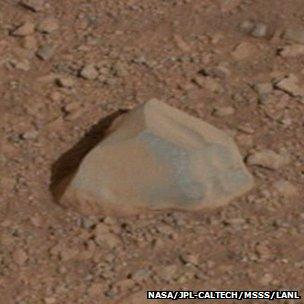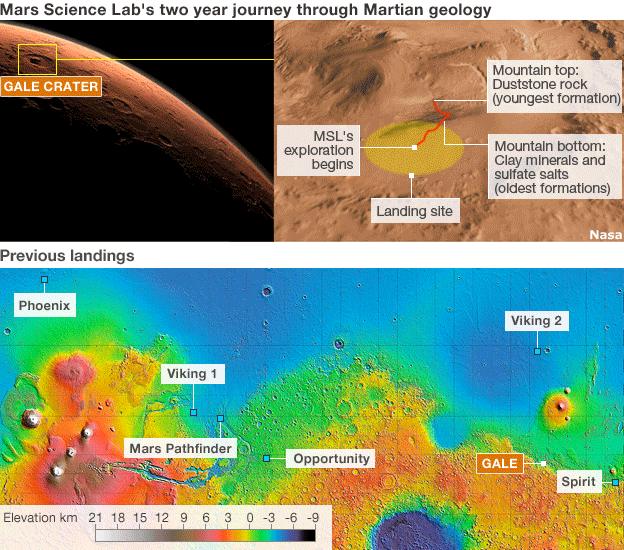Nasa's Curiosity rover zaps Mars rock called Coronation
- Published

The 7cm Coronation rock offered a smooth face to Curiosity's laser instrument (ChemCam)
Nasa's Curiosity rover has zapped its first Martian rock.
The robot fired its ChemCam laser at a tennis-ball-sized stone lying about 2.5m away on the ground.
The brief but powerful burst of light from the instrument vaporised the surface of the rock, revealing details of its basic chemistry.
This was just target practice for ChemCam, external, proving it is ready to begin the serious business of investigating the geology of the Red Planet.
It is part of a suite of instruments on the one-tonne robot, which landed two weeks ago in a deep equatorial depression known as Gale Crater.
Over the course of one Martian year, Curiosity, external will try to determine whether past environments at its touchdown location could ever have supported life.
The US-French ChemCam instrument will be a critical part of that investigation, helping to select the most interesting objects for study.
The inaugural target of the laser was a 7cm-wide rock dubbed "Coronation" (previously N165).
It had no particular science value, and was expected to be just another lump of ubiquitous Martian basalt, a volcanic rock.
Its appeal was the nice smooth face it offered to the laser.
ChemCam zapped it with 30 pulses of infrared light during a 10-second period.
Each pulse delivered to a tiny spot more than a million watts of power for about five billionths of a second.
The instrument observed the resulting spark through a telescope; the component colours would have told scientists which atomic elements were present.
"We got a great spectrum of Coronation - lots of signal," said ChemCam principal investigator Roger Wiens of Los Alamos National Laboratory, New Mexico.
"Our team is both thrilled and working hard, looking at the results. After eight years building the instrument, it's pay-off time."
One aspect being considered by the team is whether the signal changed slightly as the laser burrowed through any exterior layers that might have coated Coronation.
"Coatings can tell you about, say, the weather or what has happened to a rock through the eons," Dr Wiens told the BBC last week.
"We will look at the first few laser shots and see if there is any difference as we move further into the rock."
'Fire marks'
The British company e2v, external provided the imaging sensor behind the ChemCam telescope that routes the light signal, via optical fibres, to the onboard spectrometer which does the chemical analysis.
The charge-coupled device (CCD) was specially prepared for the instrument to increase its sensitivity.
"The scientists always want to see more, but they want to see more without cost to performance," said e2v's Jon Kemp.
"Our process was able to almost double the signal to noise ratio."
The first science target for ChemCam will be bedrock exposed on the ground next to Curiosity by the rocket-powered crane used to lower the vehicle to the crater floor on 6 August (GMT).
Exhaust from this descent stage scattered surface grit and pebbles to reveal a harder, compact material underneath.
The crane made four scour marks in the ground - two either side of the rover. These have been dubbed Burnside, Goulburn, Hepburn and Sleepy Dragon - names taken from ancient rock formations in Canadian North America.
Goulburn Scour will be zapped by ChemCam once the mission team has reviewed fully the Coronation performance and results.

The laser focuses the energy of a million light bulbs on an area no bigger than a pinprick for a few billionths of a second
This heats the surface of the target rock to high temperatures, exciting the atoms present into producing a flash of light
A telescope and camera system observes the spark (plasma) and feeds the light signal to the rover's body via a fibre optic cable
Three spectrometers slice the light into its component colours. Every chemical element has a distinctive light signature
ChemCam can determine not only which atomic elements are present in the target rock but also their abundances
The laser can also burrow through dust or a weathered coating to see the true chemistry of Martian rocks
ChemCam will be the busiest instrument on Curiosity, helping to select the most interesting objects for investigation

Jonathan.Amos-INTERNET@bbc.co.uk and follow me on Twitter, external
- Published18 August 2012
- Published14 August 2012
- Published13 August 2012
- Published11 August 2012
- Published9 August 2012
- Published9 August 2012
- Published8 August 2012
- Published7 August 2012
- Published7 August 2012
- Published6 August 2012
- Published6 August 2012
- Published4 August 2012